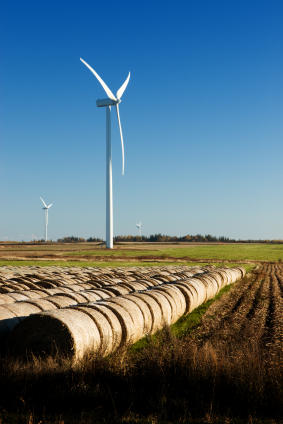
It is believed that Canada has wind potential enough to produce at least 20 percent of the country's current power needs. According to Toronto Hydro Energy Services and the Independent Power Producers Society of Ontario, the province could develop its potential and generate between 3,000 and 7,000 megawatts of wind energy in wind farms. Although useful and scientific, the Canadian wind energy atlas is nevertheless a mathematical simulation and requires further investigation, and the data available does not amount to a national wind atlas (figure 2).
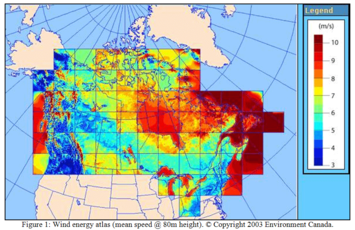
Europe and a number of other countries have developed tools and instruments to assess their wind potential, which happens to serve meteorological purposes as well. Although wind regimes are known for most of the geographic regions of the world, finer and more reliable data is essential for wind resource assessment and sound investment.
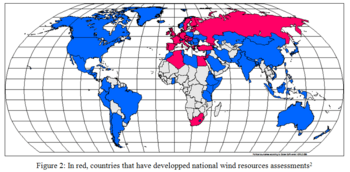 In Canada, there are three sources of information on wind resources: Environment Canada’s Meteorological Service of Canada (2004), Ontario Ministry of Natural Resources (2005), and PEI Energy Corporation, Government of Prince Edward Island (2006). In Ontario, two alignments benefit from quality wind resources, Thunder Bay – Sudbury, and Windsor – Toronto. And in Prince-Edward Island, it is the Summerside – Charlottetown stretch.
In Canada, there are three sources of information on wind resources: Environment Canada’s Meteorological Service of Canada (2004), Ontario Ministry of Natural Resources (2005), and PEI Energy Corporation, Government of Prince Edward Island (2006). In Ontario, two alignments benefit from quality wind resources, Thunder Bay – Sudbury, and Windsor – Toronto. And in Prince-Edward Island, it is the Summerside – Charlottetown stretch.
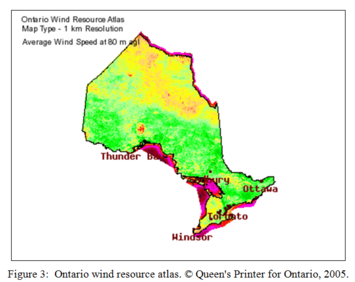
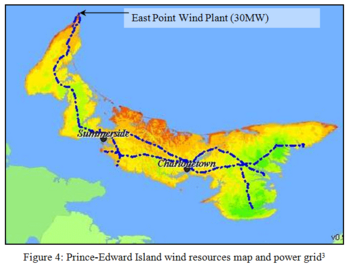 A survey of wind capacity in Canada has landed inspiring figures which translate to encouraging development perspectives for the global wind power industry. For example, Alberta has the largest installed wind capacity of any province although no data is available on the costs of these facilities. The figures collected by the Conference Board of Canada (Howatson & Churchill 2006) provide reliable data in measuring the starting point of future construction projets in view of attaining the goal: 20 percent of Canada’s needs or current demand in electrical power, if industry succeeds in securing the following pre-requisites: (i) public policies, (ii) public subsidies, (iii) environmental authorizations, and (iv) community approval of the projects.
A survey of wind capacity in Canada has landed inspiring figures which translate to encouraging development perspectives for the global wind power industry. For example, Alberta has the largest installed wind capacity of any province although no data is available on the costs of these facilities. The figures collected by the Conference Board of Canada (Howatson & Churchill 2006) provide reliable data in measuring the starting point of future construction projets in view of attaining the goal: 20 percent of Canada’s needs or current demand in electrical power, if industry succeeds in securing the following pre-requisites: (i) public policies, (ii) public subsidies, (iii) environmental authorizations, and (iv) community approval of the projects.
According to the Conference Board of Canada, adequate wind resources must be a definite characteristic of a site to enable ‘wind turbines to consistently produce a high output of power’ (Howatson & Churchill 2006, p.i). Of course, this underlines the fact that the issue adressed here is the massive production of power, the kind of output that would add to the overall regional generation and not MWs that are intended to supply local needs. This will become important when safety and reliability are factored in. A site must also be at short range of transmission lines.
The combined experience of both Denmark and Germany has indicated “that as the share of power generation from wind approaches 20 percent in a region, both transmission and backup requirements become more costly” (Howatson & Churchill, p.i). Indeed, such a substantial setup of backup capacity is an inefficient use of scarce resources unless export is considered or, as is the case for Prince-Edward Island (PEI), unless the objective is to drop combustive generation entirely (attempted horizon 2015). The latest figures compiled from CANWEA (Canadian Wind Energy Association, a non-profit trade association), indicate that in coming years (to 2012) Canada’s wind power generation will have more than doubled, from 1450, 26 MW (installed) in 2006 to 2636,40 MW (figure 7). The generation of wind generated electricity is expected to double (or almost) in five Canadian provinces: Nova Scotia, Ontario, Prince-Edward Island, Québec, New Brunswick (starting from nil).
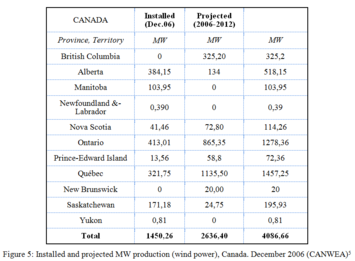 In the process of establishing adequate wind maps in the Canadian Maritimes, provincial governments and researchers at Université de Moncton – and the PEI population in general, have agreed to “a long term goal to supply 100 percent of its electrical capacity through renewable energy sources by 2015” (MacDonald 2005). In PEI, the energy to supply the needs of the 138,000 population (56 percent in rural settings) is as follows: 80 percent fossil fuels, 13 percent imported from New Brunswick via underwater cable, 6.5 percent other combustive sources (biomass, including wood, solid waste, and sawmill residue), and 0.5 percent locally generated wind power. That is 87 percent from combustion processes. The overall demand in PEI is approximately 130 MW and therefore the 30 MW East Point Wind Plant would supply almost 25 percent of present needs. Ironically, a brand new 50 MW diesel combustion turbine generator was commissionned early in 2006 at the Maritime Electric Charlottetown plant in PEI, Canada.
In the process of establishing adequate wind maps in the Canadian Maritimes, provincial governments and researchers at Université de Moncton – and the PEI population in general, have agreed to “a long term goal to supply 100 percent of its electrical capacity through renewable energy sources by 2015” (MacDonald 2005). In PEI, the energy to supply the needs of the 138,000 population (56 percent in rural settings) is as follows: 80 percent fossil fuels, 13 percent imported from New Brunswick via underwater cable, 6.5 percent other combustive sources (biomass, including wood, solid waste, and sawmill residue), and 0.5 percent locally generated wind power. That is 87 percent from combustion processes. The overall demand in PEI is approximately 130 MW and therefore the 30 MW East Point Wind Plant would supply almost 25 percent of present needs. Ironically, a brand new 50 MW diesel combustion turbine generator was commissionned early in 2006 at the Maritime Electric Charlottetown plant in PEI, Canada.
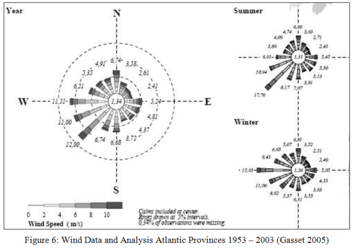
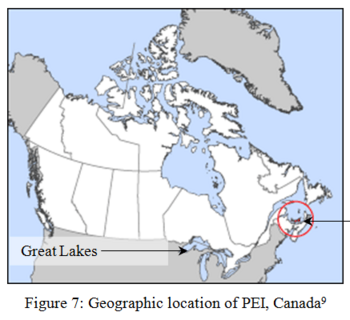
Wind maps are hardly new and the recent interest in them has taken stock of the develoment in computer programs and methods. The 50-year data and analysis below (figure 6) indicates the general direction of winds in the Canadian Maritimes and therefore the dispersion of atmospheric pollutants generated in combustive production plants (figures 8 and 9).
CONCLUSION
It would seem that taxpayers, voters and consumers would be pressing governments to subsidize industry toward the development of clean energy sources and technologies, yet this remains to be seen because new, more complex energy sources cannot forseeably replace oil or combustion energy in transportation and industry (67.1 percent of all energy consumed in Canada by the transportation and industrial sectors – and residential, commercial/institutional and agriculture buy the rest).
Although the discussion concerns electric power, the ambient discussions remain focused on oil and combustion processes including nuclear (which exploits the classic force of steam). We have included rather unpalatable technotes at the outset of this paper because energy is first and foremost a scientific concept – not a commodity, and certainly not the locus of miracles that it has been in prescientific ages, and much may be hidden or concealed in measurement units and conversion factors, including the conversion of energy forms.
Wind power and the technologies that support this approach are rather primitive, yet they offer sound opportunities for the continued development of life on earth unlike oil and its supporting attribute, internal combustion (including nuclear) with their foul emissions and deadly waste. Geographically, however, the exploitation of wind power on a global scale would bring about a redeployment of human establishments apparently detrimental to developing countries only because most countries, including the affluent, are growth-driven. Indeed, populations and cultural features are displaced when huge hydroelectric projects are implemented, but wind farms may require that people live under spinning and humming skies.
In this paper, we have identified the trend-setting Canadian province of Prince-Edward Island (PEI) as an example. PEI intends to satisfy most of its run of the mill local power needs using wind and thus curb both energy imports and GHG emissions. Nevertheless on the island, transportation, waste management (biomass as it is called now and/or cogeneration) and energy backup will continue to burn diesel and depend on combustion processes generally. The PEI experiment or project is being established under the supervision of Canadian R&D experts at the Université de Moncton (K.C. Irving Chair in Sustainable Development). In the latter case, the base-load power production is reversed.
Canada will continue, it seems, to afford itself with the best available local sources of energy and will export some surpluses to its neighbor, but clearly in our view the current demand for energy does not apply its pressure on residential, commercial and agricultural or institutional markets: the pressure is clearly on transportation and industry, and electric power is not a solution to those problems.
References
Bregha, F. (2006) Energy Policy, in The Canadian Encyclopedia © 2006 Historica Foundation of Canada. Online: http://www.thecanadianencyclopedia.com/PrinterFriendly.cfm?Params=A1ARTA...
Gasset, N. (2005) Atlas éolien du Nouveau-Brunswick. Thèse de maîtrise en études de l’environnement : conférence publique. Faculté des études supérieures et de la recherche, Centre de génie éolien, Université de Moncton. Online : http://www.umoncton.ca/cge/atlas_eolien/pdf/Presentation_annonce.pdf
Hepperle, M. (2005) Timetable: Development of the Propeller. Online : http://www.mh-aerotools.de/airfoils/prophist.htm
Hoogwijk, M.M. (2004) On the global and regional potential of renewable energy sources. Universiteit Utrecht. Online : http://igitur-archive.library.uu.nl/dissertations/2004-0309-123617/full.... (2.28 MB)
Howatson, A., and Churchill, J.L. (2006) International Experience With Implementing Wind Energy. Ottawa : Conference Board of Canada. Online : http://www.conferenceboard.ca/documents.asp?rnext=1537
MacDonald, K. (2005) East Point Wind Plant (30MW) Project Description. King’s County, Prince Edward Island. WPPI Registration #: 5902-P7-1.
Mota, W.S. and Alvarado, F.L. (2001) Dynamic coupling between power markets and power systems. Revista Controle & Automaçao, Vol.12 no.1, p.36-41. Online: http://www.fee.unicamp.br/revista_sba/vol12/v12a277.pdf
Mudge, T. (2000) Power: A First Class Design Constraint for Future Architectures. High Performance Computer Conference, Bangalore, India, Dec. 00. Online : http://www.eecs.umich.edu/~panalyzer/pdfs/Power__A_First_Class_Design_Co...
NEB (National Energy Board of Canada) (2006) Emerging Technologies in Electricity Generation. An Energy Market Assessment. Ottawa : Her Majesty the Queen in Right of Canada as represented by the National Energy Board. Online : http://www.neb.gc.ca/energy/EnergyReports/EMAEmergingTechnologiesElectri...
NEB (National Energy Board of Canada) (2004) A Compendium of Electric Reliability Frameworks Across Canada. Online : http://www.neb.gc.ca/energy/EnergyReports/CompendiumElectricReliabilityC...
NEB (National Energy Board of Canada) (2003) Canadian Electricity Exports and Imports. Online : http://www.neb.gc.ca/energy/EnergyReports/EMAElectricityExportsImportsCa...
Price, M. and Bennett, J. (2002) America's Gas Tank. The High Cost of Canada’s Oil and Gas Export Strategy. Ottawa: Natural Resources Defense Council and Sierra Club of Canada. Online: http://www.nrdc.org/land/use/gastank/gastank.pdf
Wildi, T. (2002) Electrical machines, Drives, and Power Systems. 5th Ed. Upper saddle River : Prentice Hall.
Wilson, K.G. (1999) Du monopole à la compétition : la dérèglementation des télécommunications au Canada et aux Etats-Unis. Québec : Télé-université.












